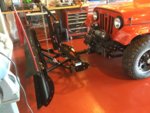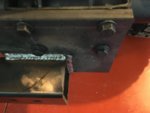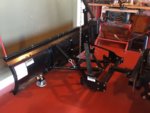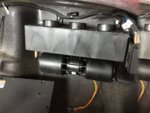Now that I have the cab enclosure installed and with winter coming here in Northern Michigan, a heater makes a nice addition. Here is a brief rundown of how I installed the heater in my Roxor.
View attachment 1564
This photo shows the heater mounted at the center of the dash and about even with the face of the dash. This seemed to be the best location for this particular heater. I used a Maradyne H-410312 heater. It's available on Amazon for about $130 at the time of this writing.
View attachment 1565
For mounting the upper part of the heater, I made some aluminum brackets. These are simple. I used 1/8 x 1 aluminum that I bought at the local hardware store. I cut the length needed and bent it and drilled the holes. The bracket is held to the heater using a #10 sheetmetal screw. It fastens into the slotted hole near the top of the side of the heater. The bracket attaches to the bottom of the dash using #10 machine screws with stop nuts. The dash is too thick to use sheetmetal screws. There is an angle bracket on each side of the heater.
View attachment 1566
The lower part of the heater is attached directly to the floor tunnel. The flanges that are part of the heater case only need a slight twist and bend inward to make them fit right against the floor. For fasteners, I used 1/4 x 1 nuts and bolts.
View attachment 1567
The wiring is routed over to the fuse box under the right side of the dash. I connected the positive wire to fuse F28. This fuse appears to be unused on my Roxor and is a 10 amp fuse. Power to this fuse shuts off with the key which is perfect. There are two factory wires going to this fuse. You want to splice into the wire that is closest to the outer part of the fuse box. For the ground wire, I connected it to an existing ground stud above the fuse box. You will have to add a nut to the stud.
View attachment 1569
In this photo, you can see the two heater hoses coming through the firewall. Heater hoses come in various colors, I chose black so that it looks OK under the hood since the factory hoses are black. Be sure to use a good quality heater hose. Some will kink too bad when making a bend. You also want good quality hoses since these are routed into the interior and a leak could be bad. The hoses are 5/8ths inch inside diameter. I bought 6 feet of hose so I would have enough for the job. I actually ended up using less than 5 feet of the hose.
View attachment 1571
Under the hood, there are a couple of different ways to run the hoses and it all depends on the type of heater you use. Mine has a shut off valve on it. Some heaters do not have a shut off valve. For my heater with the shut off valve, the hoses can only be routed one way, in parallel with the hoses that run to the EGR cooler. For heaters without a shut off valve, the hoses can be run just like I did, or they can be run in series with the EGR cooler hoses. In series means a hose runs from the engine to the EGR cooler, then from the outlet of the cooler to the inlet of the heater, and then from the outlet of the heater back to the engine. In parallel mode like my setup, we have to tap into the two EGR cooler hoses with T-fittings. If we use the "series" mode, closing the valve on the heater will shut off the coolant flow through the EGR cooler and that is not a good thing.
This photo shows how I tapped into the pressure side hose using a T-fitting. I bought the 5/8ths T-fittings at the local NAPA auto parts store.
View attachment 1573
This photo shows how I tapped into the return hose from the EGR cooler. I cut the hose right where it makes a 90 degree bend and added the T-fitting there.
View attachment 1575
Here you can see how the pressure hose to the heater inlet is routed along side the valve cover. It looks good like this.
View attachment 1577
This photo gives a closer look at the firewall where the hoses go through the factory grommets. I cut the center out of the grommets enough so they would slide over the hoses. After cutting them, put them back into the firewall. You'll need to wipe a slight film of lubricant over the hoses so they push through the grommets easily or they'll pop out as you push the hoses through. I lightly wiped WD-40 onto the hoses. It dried later. A little lubricant applied inside the hoses might also make it easier to slide the hoses over the T-fittings.
View attachment 1580
This heater works quite well and will make it fun to run the Roxor around the county this winter. Our county allows side by sides to run on the roads as long as we stay to the right, allow cars to easily pass, and keep it below 25 mph. We can go anywhere as long as we stay off the federal and state roads. We've taken the Roxor just about everywhere we need to go here.[/QUOTE
Thanks for your post about the heater.
Do you like the windshield you have? Does it bow in at 45 + MPH?






